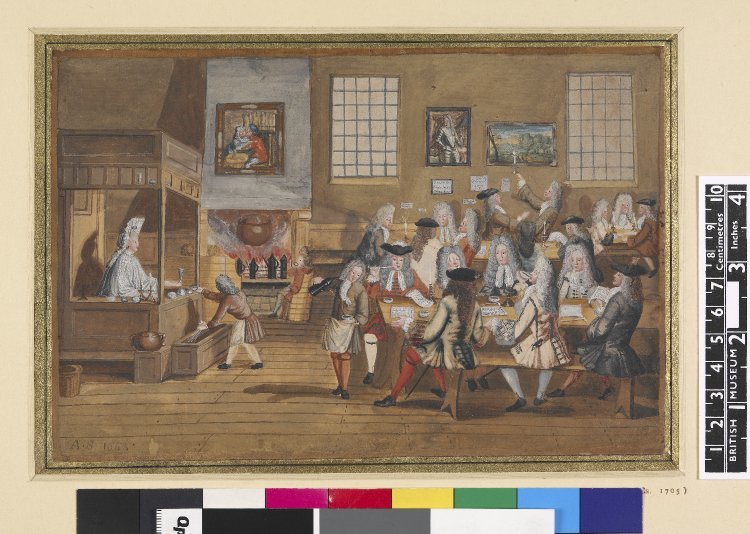Without Women (1670-1750)
In the print "A Coffeehouse In the Time of Charles II", five men sit around a table in 17th-century clothing while talking and drinking coffee. An additional man walks towards the table with a cup and a pot. No women are present in the illustration. The artist is unknown and the drawing is from a woodcut. The image was created in 1674 and is used in the book Coffee Merchandising: A Handbook to the Coffee Business Giving Elementary and Essential Facts Pertaining to the History, Cultivation, Preparation, and Marketing of Coffee by William H. Ukers. The book is most likely directed at people who were interested in starting and running a coffee business. This image appears in the History section of the book. Although the audience who would be viewing this image is unclear, this image could have been easily reprinted from the original wooden print and circulated.
Matthew White, a Research Fellow in History at the University of Hertfordshire, describes how the British coffeehouse first appeared in the 1650s in Oxford (White). It was modeled after Turkish coffeehouses and was created by “a Greek servant to the Levant Company, Pasqua Rosée” (White). The early coffeehouses were mainly visited by wealthy educated men who came to show off their intellectual prowess (White). In this picture, there are no women present most likely because the men are focused on intellectual pursuits inside the coffeehouse and a woman would be a distraction. Discussing politics, business, and scholarly debate was traditionally a masculine occupation (Cowan 228). If this image was a part of an advertisement for a coffeehouse, the commissioner would want the artist to be very clear about the kind of people they want to attract. Having no women present makes the viewer see the coffeehouse discussions as open to men only.
In the image, “A London Coffee-house With Men Working”, many men are present on the right side of the image. They are discussing paintings on walls and reading papers on the tables. One male server pours a cup of coffee, while another goes to the bar to get a cup from the woman inside the booth. The author of the painting is unknown and it is dated between 1690 and 1700.
Women were present in coffeehouses from the beginning of the coffeehouse’s development as an institution. According to Markman Ellis, a professor of eighteenth-century studies at Queen-Mary, University of London, “In the magistrates' survey in 1663 two women coffeehouse keepers were identified: Widow Bowman in Cornhill and Widow Allen in Farringdon-within. These were by no means the only ones” (Ellis 109). Ellis then lists several other women who ran coffeehouses between 1660 and 1730 (Ellis 109-110). The woman in this painting may be a coffeehouse keeper because she is working in the coffeehouse, and she isn’t directly serving the men. The men in the painting are pursuing intellectual conversations, similar to the men in the previous painting, about art and about the news. The woman’s presence in the painting creates a distinction between males and females within the coffeehouse. The men are able to hold intellectual discussions, while the woman is not. The men are drinking coffee, while the woman is not. The painting itself is divided with the woman on the left side of the image and the majority of the men on the right side of the image. By emphasizing the difference between men and women the painting portrays the coffeehouse as an intellectual space only accessible to men. The male viewers may feel more secure in their identity as men because the boundary between masculinity and femininity is made visible in this painting. When the men and women are portrayed as separated within these works of art they become examples of how to conform to the societal standards set for men and women.


